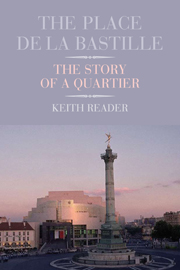Book contents
- Frontmatter
- Contents
- Acknowledgements
- Map by Stephen Ramsay Cartography
- Introduction: The Place de la Bastille
- 1 ‘What's that poor creature doing here?’: the area and the fortress before the Revolution of 1789
- 2 ‘Thought blew the Bastille apart’: the fall of the fortress and the revolutionary years, 1789–1815
- 3 ‘The strategy of the generals of Africa shattered’: the Restoration, Orleanist and Second Republic Years, 1815–1851
- 4 ‘Where is the noise of the storm that I love?’: The Second Empire from Haussmann to the Commune
- 5 ‘Satan's bagpipes’: La Belle Époque's forty-three years of peace
- 6 ‘Villains, stars and everybody in between’: The First War and the entre-deux-guerres
- 7 ‘Slicked hair and splendid sideburns’: Occupation and Liberation
- 8 ‘Let's have some sun!’: post-Gaullism and the Mitterrand years
- 9 ‘A building, not a monument’: the construction of the Bastille Opéra
- 10 ‘A real earthquake’: the impact of the Opéra on the quartier
- 11 Flânerie in the archive: the Faubourg/Bastille today
- Notes
- Bibliography
- Index
5 - ‘Satan's bagpipes’: La Belle Époque's forty-three years of peace
- Frontmatter
- Contents
- Acknowledgements
- Map by Stephen Ramsay Cartography
- Introduction: The Place de la Bastille
- 1 ‘What's that poor creature doing here?’: the area and the fortress before the Revolution of 1789
- 2 ‘Thought blew the Bastille apart’: the fall of the fortress and the revolutionary years, 1789–1815
- 3 ‘The strategy of the generals of Africa shattered’: the Restoration, Orleanist and Second Republic Years, 1815–1851
- 4 ‘Where is the noise of the storm that I love?’: The Second Empire from Haussmann to the Commune
- 5 ‘Satan's bagpipes’: La Belle Époque's forty-three years of peace
- 6 ‘Villains, stars and everybody in between’: The First War and the entre-deux-guerres
- 7 ‘Slicked hair and splendid sideburns’: Occupation and Liberation
- 8 ‘Let's have some sun!’: post-Gaullism and the Mitterrand years
- 9 ‘A building, not a monument’: the construction of the Bastille Opéra
- 10 ‘A real earthquake’: the impact of the Opéra on the quartier
- 11 Flânerie in the archive: the Faubourg/Bastille today
- Notes
- Bibliography
- Index
Summary
The term La Belle Époque – broadly cognate with the English ‘naughty nineties’ – can be narrowly defined as spanning the period between 1896, when France emerged from a prolonged economic depression, and the outbreak of the First War in 1914. It is sometimes, if inaccurately, extended as far back as 1871, doubtless because that date inaugurated forty-three years of peaceful constitutional stability. That may seem a modest achievement to an Anglophone readership, but after the turmoil of the ‘short nineteenth century’ since the Revolution of 1789 it was something new for France, and the romantic aura with which the phrase is surrounded owes a great deal to the political calm and, in its second half, the economic prosperity characteristic of the period. Entertainment became an increasingly important and diversified part of the quartier's life, notably the bals-musette of which I shall say more shortly. The cinema, invented in 1895, rapidly became an important entertainment medium, with numerous movie-theatres opening, sometimes fleetingly, in the area, ranging in size from the 1000-seater Cyrano in the rue de la Roquette to the Kinéma Bijou under the railway arches, which seems to have operated only in 1911, and the Keller in the place Voltaire (now the place Léon Blum), which proudly proclaimed itself the smallest cinema in Paris during its five-year lifespan from 1907.
If revolutionary fervour in the Faubourg waned after the suppression of the Commune, this may have been at least in part because France had once again become, as it has remained to this day, a republic.
- Type
- Chapter
- Information
- The Place de la BastilleThe Story of a Quartier, pp. 73 - 88Publisher: Liverpool University PressPrint publication year: 2011



